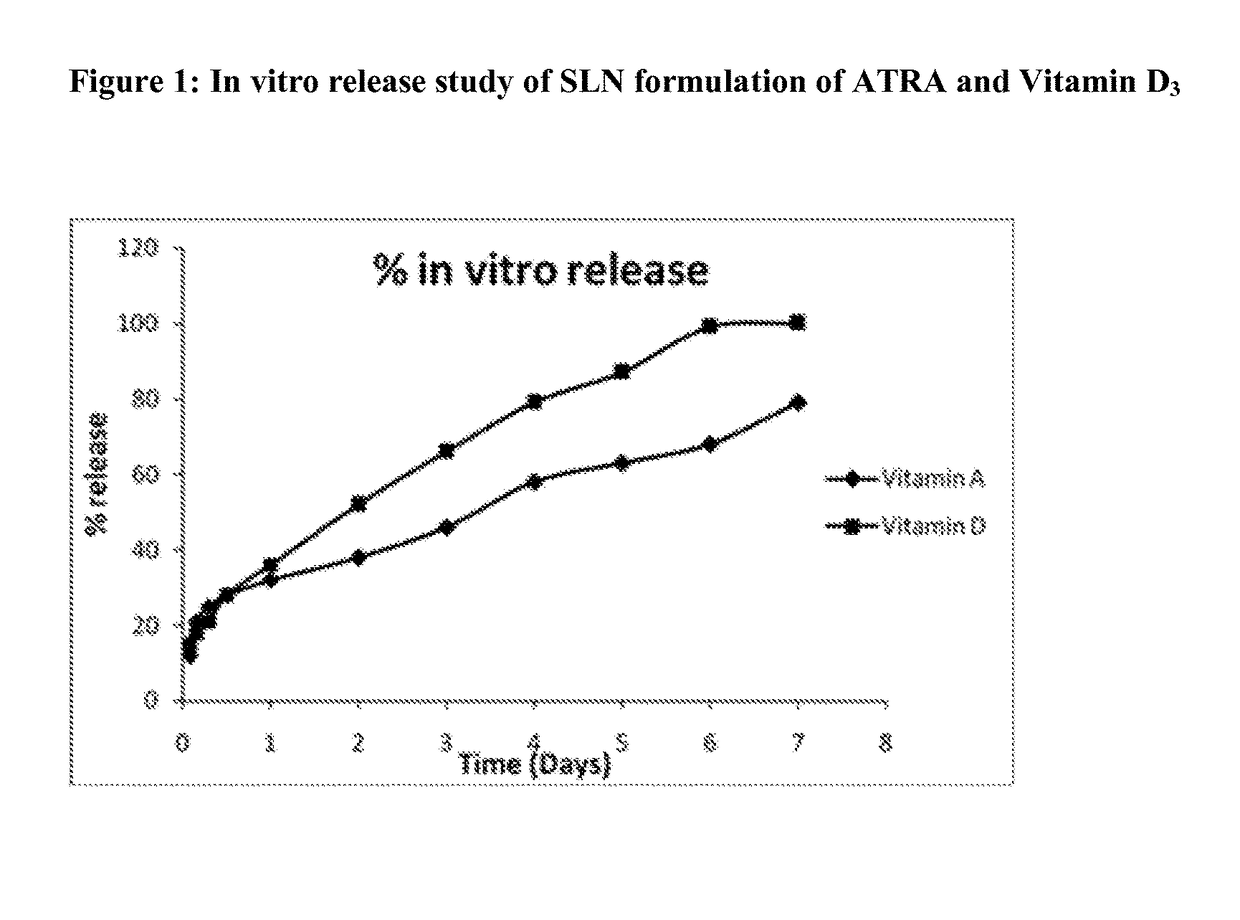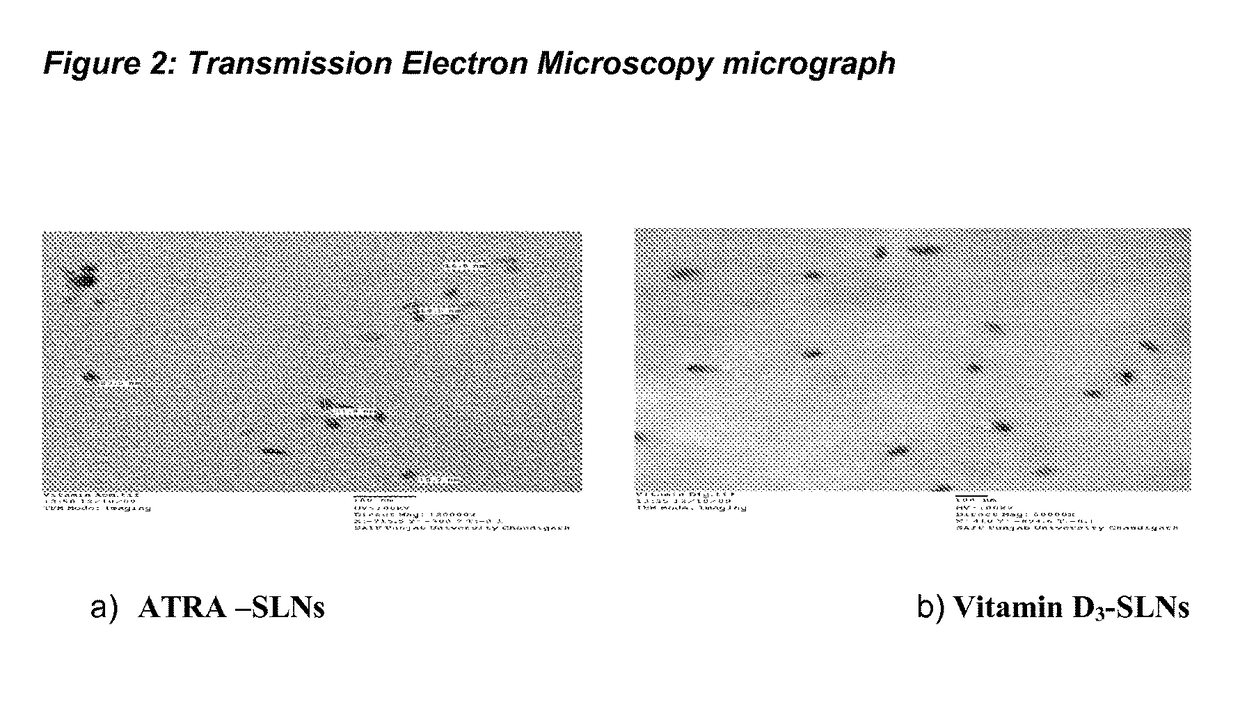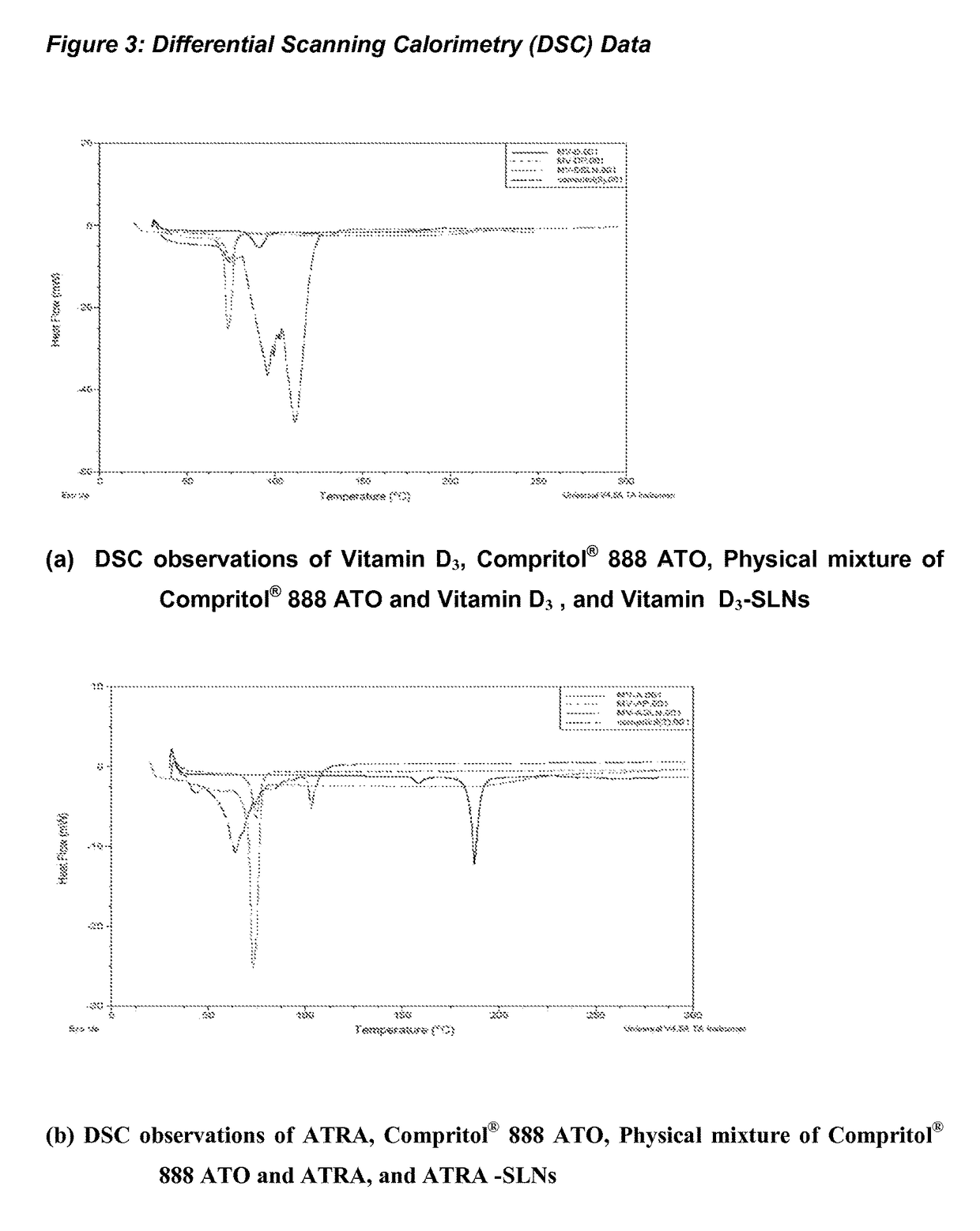Process for preparing solid lipid sustained release nanoparticles for delivery of vitamins
a technology of solid lipids and nanoparticles, applied in the field of nanobiotechnology, can solve the problems of low entrapment efficiency, erratic release profile, and nanoparticles produced by the earlier methods known in the prior ar
- Summary
- Abstract
- Description
- Claims
- Application Information
AI Technical Summary
Benefits of technology
Problems solved by technology
Method used
Image
Examples
example 1
Materials and Methods
1. Drug Excipients Interaction Studies
[0093]Drug excipients interaction studies were done at 4° C., 40° C., 40° C. and 75% RH for 1 month. Selection of lipid was done from a repertoire of lipids such as, glyeryl mono, di, tri, glycerides, stearic acid, glyerylpalmitostearte, glycerylmonostearte, palmitic acid, oleic acid, saturated and unsaturated fatty acids. These lipids were mixed with surfactants, such as tween 20, tween 40, tween 60, tween 80, span 20, span 40, Span 60, poloxamers, PEG (400, 600, 4000, 6000) etc. and co-surfactants blend selected from Phospholipon G, Phospholipon H, egg lecithin, Soy lecithin etc. Purified and sterile water was used all throughout the study.
2. Process for Preparation of SLNs by Microemulsification Method
[0094]Optimized formulation comprising of emulsifiers such as Polysorbate 80 (45.45%), soy lecithin (0.58%), and water were placed together in a beaker and heated to the lipid melt temperature. Lipid (7.27%) was melted separ...
example 2
Results
Analytical Method Development:
[0108]HPLC / UPLC method development for simultaneous determination of free drugs and drug incorporated in SLNs and applicability for pharmacokinetics.
[0109]
HPLC ALLIANCE SYSTEM e2695UPLC, AQUITY H-ClassS.with EMPOWER 2 SOFTWAREwith EMPOWER 2 SOFTWARENoParameterVitamin AVitamin DVitamin AVitamin D1ColumnC18C18BEH C18BEH C182MobileACN:MeOH:WaterACN:MeOH:WaterACN:MeOH:WaterACN:MeOH:Waterphase90:8:290:8:290:8:290:8:23Run time6 min6 min5 min5 min4Flow rate1.0 ml / min1.0 ml / min0.2 ml / min0.2 ml / min5Retention2.5 min3.4 min0.98 min2.5 mintime6(R2)0.9990.9990.9990.999
Characterization: Particle Size, Total Drug Content and Entrapment Efficiency of Vitamin A and D3
[0110]
ZetaParticle size Polydispersitypotential*Total drugEntrapmentFormulation(nm) (n = 3)Index (PI)(mV)content (%)(%) (n = 3)Retinoic acid157.0 ± 4.00.203−12.4592.50 ± 2.10%84.60 ± 3.20%Vitamin D3147.0 ± 6.00.230−2.6191.2 ± 2.1 84.65 ± 2.7
Particle Size Analysis
[0111]The particle size is one of t...
example 3
Formulation 1
[0134]Glyceryl monostearate was melted at their melting point. Drug was added to the lipid phase. Lecithin and poloxamer dissolved in water were heated to the lipid melting point and added to the lipid phase. A clear and hot microemulsion was formed which was poured into ice-chilled water and homogenized for 30 minutes. Nanoparticles thus formed were characterized for particle size, total drug content, and entrapment efficiency. In-vitro release studies were performed with the developed dispersion.
[0135]
S NoIngredientsmg / batch1.Vitamin D3 / Retinoic acid30.002.Glyceryl monostearte300.003.Poloxamer 4078.004.Lecithin (4% solution of soya lecithin)0.1 ml5.Water4.5 ml
Formulation 2
[0136]Vitamin D3 / Retinoic acid and all other excipients were dispensed as per the formula. Briefly, Compritol was melted at its melting point. Drug was added to the lipid phase. Lecithin and Span 60 was added to hot aqueous phase maintained at the same temperature after which the two phases were mixe...
PUM
| Property | Measurement | Unit |
|---|---|---|
| temperature | aaaaa | aaaaa |
| temperature | aaaaa | aaaaa |
| particle size | aaaaa | aaaaa |
Abstract
Description
Claims
Application Information
 Login to View More
Login to View More - R&D
- Intellectual Property
- Life Sciences
- Materials
- Tech Scout
- Unparalleled Data Quality
- Higher Quality Content
- 60% Fewer Hallucinations
Browse by: Latest US Patents, China's latest patents, Technical Efficacy Thesaurus, Application Domain, Technology Topic, Popular Technical Reports.
© 2025 PatSnap. All rights reserved.Legal|Privacy policy|Modern Slavery Act Transparency Statement|Sitemap|About US| Contact US: help@patsnap.com



